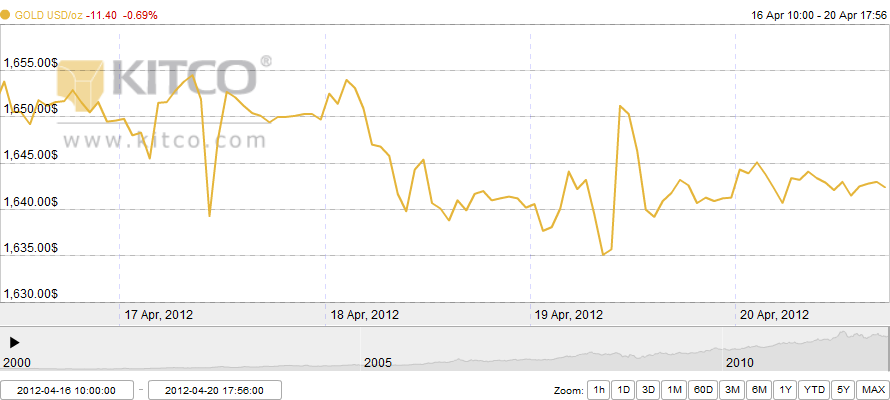Monday April 16th Open: $1,651.30
Weekly Low: $1,635.10
Weekly High: $1,654.40
Friday April 20 Close: $1642.30
Gold prices have been on the downturn this week, lingering under $1,650 on Monday, dropping to $1,642. Gold prices have been following a slight but steady decline since late February, yet the price of gold stabilized on Thursday’s closing after several U.S. economic reports revealed that the American economy has not performed as well as expected in the past week. The gold market is unique because while most commodities markets may look forward to a booming economy, gold’s currency market actually hinges on its place as a hedge against economic downturn. Thus, when the economy seems to be on an upturn, gold prices fall.
U.S. Economic Performance
Take a look at these weekly statistics for U.S. economic performance, according to International Business Times:
- Unemployment claims numbered at 386,000, higher than the expected 370,000
- Home sales clocked in at only 4.48 million, less than the expected 4.61 million
- Manufacturing activity dropped to 8.5%, falling short of the 10.8% estimate
As the market opened on Thursday, gold prices started at $1,645 per ounce, dropped down to $1,631.48 but then bounced back to hold steady around its opening value after these economic reports showed less than expected gains.
Gold Price Per Month
Though the first month of 2012 showed gold performing very well, the past few months have not been as strong as January. Gold prices slowed in February, dropped to their lowest of the year in March, and are now in flux. March ended with a 2.86% drop in gold prices. Lior Cohen of Trading NRG cites a number of reasons for this:
- The Federal Open Market Committee (FOMC) held its second meeting of the year on March 13th, and Cohen uses this date as a marker to show gold’s decline. Because the U.S. economy is seeing a slow upturn, the FOMC decided not to take action or deploy stimulus plans, and instead maintain its current trajectory of low interest rates. Following this news, the U.S. stock market has been rising and the dollar is appreciating, contributing to the tumbling prices of gold.
- The U.S. Labor Report for March showed employment unexpectedly rising drastically.
- India (the largest importer of gold) experienced protests against the tax measure on gold imports.
- China’s economic stability has been in question, and since they are also a prominent importer of gold, this has caused concerns among investors.
- U.S. GDP expanded by 3% in the fourth quarter of 2011, contributing to the strengthening of the dollar.
Looking Forward
This week has also ended with a general decline in gold prices, about 2% since January, but there are some upcoming events that may play a great role in gold market values. The FOMC will be meeting again toward the end of April, which may influence prices as before depending on their policies, and April 24th is a date to mark on the calendar as the biggest gold-buying day in India. It’s the Hindu festival of Akshaya Tritivai, a day on which buying gold brings luck; it’s the beginning of the wedding season, where gold is prominently bought and worn; and last week marked the end of the 20-day long strike on India’s tax on gold imports.
Most analysts predict gold will still be a volatile investment, hovering between $1,500 and $2,000 per ounce.

Leave a Reply